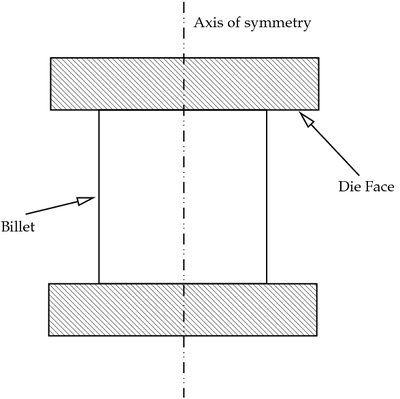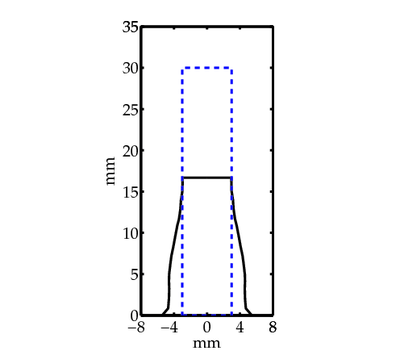Nonlinear finite elements/Homework 11
< Nonlinear finite elementsProblem 1: Small Strain Elastic-Plastic Behavior
For small strains, the strain tensor is given by
In classical (small strain) rate-independent plasticity we start off with an additive decomposition of the strain tensor
Assuming linear elasticity, we have the following elastic stress-strain law
Let us assume that the  theory applies during plastic deformation of
the material. Hence, the material obeys an associated flow rule
theory applies during plastic deformation of
the material. Hence, the material obeys an associated flow rule
where  is the plastic flow rate,
is the plastic flow rate,  is the yield function,
is the yield function,
 is the temperature, and
is the temperature, and  is an internal variable.
is an internal variable.
Answer the following questions. Show your derivations in a clear and step-by-step manner.
Part 1
Let  be the equivalent plastic strain, defined as
be the equivalent plastic strain, defined as
Express the time derivative of  in terms of
in terms of  and
and
 . This is the evolution law for
. This is the evolution law for  .
.
Part 2
For an adiabatic process, the rate of change of temperature can be written as
where  is the Taylor-Quinney coefficient,
is the Taylor-Quinney coefficient,  is the density,
and
is the density,
and  is the specific heat. Express
is the specific heat. Express  in terms of
in terms of
 and
and  . This is the
evolution law for
. This is the
evolution law for  .
.
Part 3
Write down the rate form of the elastic stress-strain law. Assume that deformations are small so that objectivity of the rates is not a concern.
Part 4
The consistency condition during plastic flow requires that
Write down an expression for the time derivative of
 using the chain rule.
using the chain rule.
Part 5
Use the consistency condition and the expressions you have derived
in the previous parts to derive an expression for  in
terms of
in
terms of  ,
,  ,
,
 ,
,  , and
, and  .
.
Part 6
The continuum elastic-plastic tangent modulus is defined by the following relation
Derive an expression for the elastic plastic tangent modulus using the results you have derived in the previous parts.
Part 7
The  theory of plasticity also states that the material
satisfies the von Mises yield condition
theory of plasticity also states that the material
satisfies the von Mises yield condition
where  is the deviatoric part of the stress
is the deviatoric part of the stress  .
Derive an expression for
.
Derive an expression for  in terms of the
normal to the yield surface
in terms of the
normal to the yield surface
Part 8
The yield stress  is given by the Johnson-Cook model
is given by the Johnson-Cook model
where  is the initial yield stress,
is the initial yield stress,  are constants,
are constants,
 is a reference temperature, and
is a reference temperature, and  is the melt temperature.
Derive expressions for
is the melt temperature.
Derive expressions for  , and
, and
 for the von Mises yield condition with the
Johnson-Cook flow stress model.
for the von Mises yield condition with the
Johnson-Cook flow stress model.
Part 9
Assume that the elastic response of the material is linear, i.e.,
Derive the expression for the elastic-plastic tangent modulus for a von Mises yield condition with Johnson-Cook flow stress for a linear elastic material using the expressions that you have derived in the previous parts.
Part 10
Discretize the equations for  (equation 1),
(equation 1),
 (from part 1), and
(from part 1), and  (from part 2)
using Forward Euler. Use the following notation in your discretized
equations:
(from part 2)
using Forward Euler. Use the following notation in your discretized
equations:
where  is the time step,
is the time step,  is the value
of
is the value
of  at
at  ,
,  is the value of
is the value of  at
at
 .
.
Part 11
The Kuhn-Tucker loading-unloading conditions are
Write down a discrete form of the Kuhn-Tucker conditions.
Part 12
In the radial return algorithm, we define a trial elastic state as
where  are the stress and strain at
are the stress and strain at  and
and
 are the values at
are the values at  . Show
that, if the elastic response of the material is linear,
equation (2) can be written as
. Show
that, if the elastic response of the material is linear,
equation (2) can be written as
Hint: Start by showing that
Part 13
Starting from equation (3) show that
where  is the deviatoric part of
is the deviatoric part of  and
and  is the
deviatoric part of
is the
deviatoric part of  .
.
Part 14
Show that
Hint: The stress  is given by
is given by
Express this equation in terms of  and
and  .
Then use the discretized equation for
.
Then use the discretized equation for  (part 10) and
the relation for
(part 10) and
the relation for  for isotropic elasticity. Finally compute
the deviatoric stress terms after showing that
for isotropic elasticity. Finally compute
the deviatoric stress terms after showing that
Part 15
The discretized form of the Kuhn-Tucker conditions in conjunction with the consistency condition gives us
Use this condition and the relations you have derived in the
previous sections to arrive at a nonlinear equation in  that can be solved using Newton iterations.
that can be solved using Newton iterations.
Part 16
Let the nonlinear equation be  . Recall that
the Newton method requires that we iterate using the formula
. Recall that
the Newton method requires that we iterate using the formula
where  is the Newton iteration number. Derive an expression for
the derivative of
is the Newton iteration number. Derive an expression for
the derivative of  that is required in the above formula.
that is required in the above formula.
(You can use Computational Inelasticity by J.C. Simo and T.J.R. Hughes for pointers.)
Problem 2: Billet Upset Forging
Consider the isothermal upset forging of the cylindrical billet shown in Figure 2.
 Figure 2. Upset forging of a cylindrical billet. |
Assume that the dies are rigid. Also assume that sticking friction is in effect between the billet and the die faces when they are in contact.
The billet has an initial radius of 10 mm and its initial height is 30 mm. The shear modulus of the material is 384.6 MPa, the bulk modulus of the material is 833.3 MPa, the initial yield stress is 1 MPa and the linear hardening modulus is 3 MPa.
Model a quarter of the cylinder using symmetry boundary conditions.
Apply a compressive force of 1 kN to the die.
- Plot the final shape of the billet. Compare your results with those shown in Simo and Hughes (Fig. 9.8, p. 325).
- Plot a curve of the die force (kN) versus the die stroke (mm). Compare your results with those shown in Simo and Hughes. Do you observe any volumetric locking?
(Use an implicit software to solve these problems.)
Problem 3: Taylor Impact Tests
Consider the impact of a cylindrical Taylor impact specimen on a rigid target. The undeformed and deformed profiles of the specimen are shown in in Figure 3.
 Figure 3. Taylor impact test of a cylindrical rod. |
The initial length of the specimen is 30 mm. The initial diameter is 6 mm. The initial velocity is 188 m/s. The initial temperature is 718 K.
The material of the specimen is OFHC copper. The properties of the bar are (in SI units):
| Density | 8930.0 |
| Thermal conductivity | 386.0 |
| Specific heat | 414.0 |
| Shear modulus | 46.0e9 |
| Bulk modulus | 129.0e9 |
| Coeff. Thermal Expansion | 1.76e-5 |
The plastic deformation of the specimen is described by the Johnson-Cook
model and  plasticity. The Johnson-Cook model parameters are (in SI
units):
plasticity. The Johnson-Cook model parameters are (in SI
units):
| A | 90.0e6 |
| B | 292.0e6 |
| C | 0.025 |
| n | 0.31 |
| m | 1.09 |
 |
1.0 |
 |
294.0 |
 |
1356.0 |
- Use LS-DYNA to simulate the Taylor impact test. Assume that there is no friction between the anvil and the specimen. Plot the final deformed shape of the specimen and compare that with the experimentally determined shape given in the table below. What differences do you observe and why?
Point x (mm) y (mm) 1 0.000000 0.000000 2 5.436409 0.000000 3 4.711554 0.852540 4 4.611804 2.040725 5 4.581879 3.228910 6 4.615129 4.141866 7 4.585204 4.980980 8 4.448878 6.175878 9 4.312552 7.223092 10 4.073150 8.344149 11 3.870324 9.465205 12 3.597672 10.868203 13 3.388196 11.707317 14 3.218620 12.902215 15 3.152120 13.949429 16 2.982544 15.070486 17 2.952618 16.674871 18 0.000000 16.674871 19 0.000000 0.000000 - You can generate a mesh in ANSYS and tranfer it to LS-DYNA if you want.
- Show whether energy is conserved during your simulation.
![\boldsymbol{\varepsilon} = \frac{1}{2}\left[\boldsymbol{\nabla} \mathbf{u} + (\boldsymbol{\nabla} \mathbf{u})^T\right]
\qquad\text{or}\qquad
\varepsilon_{ij} = \frac{1}{2}(u_{i,j} + u_{j,i}) ~.](../I/m/3e0528ea1083641d57f5c12abdb24b8d.png)









![\sigma_y(\alpha,T) = \left[\sigma_0 + B \alpha^n\right]
\left[1 - \left(\cfrac{T - T_0}{T_m -T_0}\right)\right]](../I/m/f7cbc76d40e8cc0bcd63fbcf1a62bd7c.png)




![\text{(3)} \qquad
\boldsymbol{\sigma}_{n+1}^{\text{trial}} =
\left[\lambda~\text{tr}(\boldsymbol{\varepsilon}_{n+1})~\boldsymbol{\mathit{1}} + 2\mu~\boldsymbol{\varepsilon}_{n+1}\right] -
\left[\lambda~\text{tr}(\boldsymbol{\varepsilon}_n^p)~\boldsymbol{\mathit{1}} + 2\mu~\boldsymbol{\varepsilon}_n^p\right] ~.](../I/m/85513053d9eea5ebaf9ba98227065df7.png)






